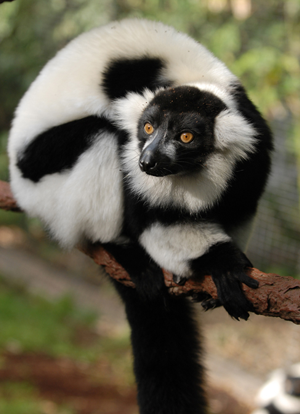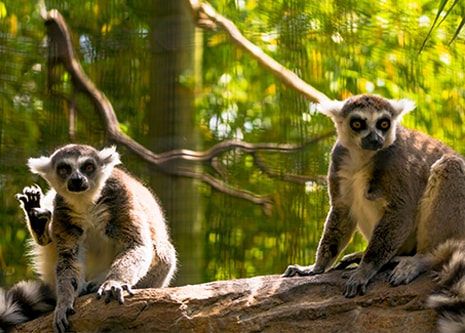
- VisitSupport Happy HollowDONATE TODAYExploreSupport Happy HollowDONATE TODAYLearnSupport Happy HollowDONATE TODAYSupport
-
Today's Hours: 10:00 am to 5:00 pm
Zoo in the HollowBlack and white ruffed lemur

Scientific name: Varecia variegata
Family: Lemuridae
Order: Primates
Class: Mammalia
Range: Isolated populations in Eastern Madagascar
Habitat: Subtropical and Tropical Forest
Lifespan: 15 to 20 years in the wild; over 30 years in captivityWhat do they look like?
Black and white ruffed lemurs are one of two species of ruffed lemurs, separated from each other by the Antainambalana River in eastern Madagascar. Black and white ruffed lemurs are named for the tufts of hair lining their ears and faces. Their faces, hands, feet, bellies, and tails are black, while they have white “ruffs” and varying blankets of white on their backs. They have large, forward-facing eyes and fox-like muzzles. Ruffed lemurs are the largest of the lemur species, typically weighing seven to 10 pounds. Their bodies are approximately 20 to 22 inches long with tails adding an additional 24 inches to their length. Although their tails may look like they are prehensile (capable of grabbing and grasping items on their own) they are only used for balance and cannot support their body weight.How do they behave?
Black and white ruffed lemurs live in small family groups typically comprised of two to five members. They are a crepuscular (active mainly during dawn and dusk) and spend most of their time foraging in the treetops. Females are dominant in the lemur hierarchy, a system unique to this suborder of prosimians. Females will defend their territory, choose their own mate, and have first access to foraging opportunities. Ruffed lemurs communicate through loud vocalizations which can be heard up to a mile away. The most common calls are alarm calls and locator calls.What do they eat?
Black and white ruffed lemurs are herbivores, and more specifically frugivores (feeding primarily on fruit) although they also consume leaves, flowers and nectar. Ruffed lemurs play an important ecological role in Madagascar. They cannot digest the seeds of the fruit they consume; the seeds are dispersed in their droppings, helping to replant vegetation throughout the region. At Happy Hollow, they eat specialized leaf-eater diet, fruits, vegetables and greens.How are they born?
Bonded pairs are believed to be monogamous among this species. Mating takes place from May to July, during the cooler, drier months in Madagascar. Toward the end of the gestation period, which lasts approximately 102 days, the female will build a nest for her young. Twins and triplets are most common; however, litters of six have been noted in captivity. Newborns are born fully furred with open eyes, though they do not have the strength yet to hold on to their mothers for travel. They will live in the nest for up to two weeks, and then the mother will begin to carry them to nearby trees while she forages.Conservation
The black and white ruffed lemur’s conservation status is listed as Critically Endangered by the International Union for Conservation of Nature . One of the main threats to these lemurs is habitat loss and human predation. In 2012 the Duke Lemur Center adopted the SAVA (Sambava-Andapa-Vohemar-Antalaha) Conservation Madagascar initiative, a program designed to improve the conservation status of lemurs in Madagascar. SAVA Conservation Madagascar focuses on community based conservation, research, and habitat preservation. If you would like to help black-and-white ruffed lemurs, you can start by purchasing coffee that is shade-grown and produce that is grown locally. These products do not require the destruction of rainforest land to grow crops and they will help out your local economy.
Zoo on the Hill
Located across from the Keep-Around Carousel is the Zoo on the Hill. Learn about wildlife up close during daily meet-and-greets, leap like a lemur on the playground, brush and feed the goats, or take a peek inside Doc’s Critter Care building and the Ranch House. Double-H Ranch features a combination of animal exhibits, including giant anteaters and red ruffed lemurs, as well chickens and domesticated animals that are docile enough to touch.
See Animals
Education Ambassadors
From camps and classes to scout badges and sleepovers, Happy Hollow education programs have something for everyone! The zoo education program offers a broad range of hands-on, engaging programs and public presentations featuring education ambassador animals. These encounters are designed to connect you to wildlife and the conservation of their habitats around the world.
See AnimalsVisit Us Today
Plan an unforgettable experience at San Jose’s family-friendly park and zoo.
Learn More